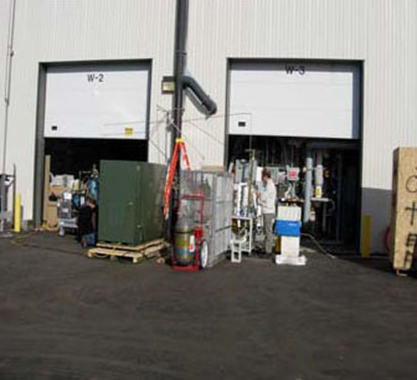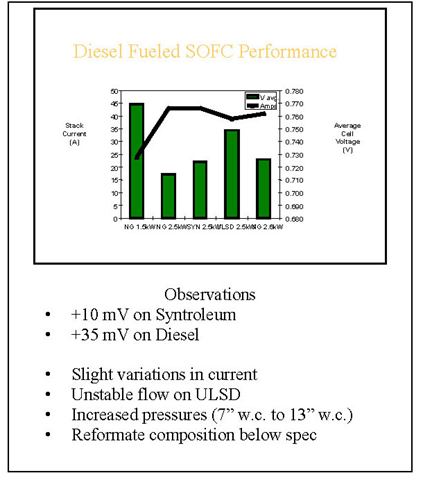Testing of a 5kWe SOFC on Diesel Reformate
Project Number
FEW 4661-06
Goal
The goal is to demonstrate operation of a solid oxide fuel cell (SOFC) on diesel fuel as an alternative power generation technology for remote Alaskan applications. The objectives of the test were to:
- Benchmark the performance of the fuel cell on natural gas at higher elevations. Tests were conducted at the Idaho National Laboratory, which is nominally at an elevation of 4,700 feet.
- Measure the SOFC performance using lower-quality reformates produced by reforming diesel fuel.
Performer(s)
Idaho National Laboratory (INL)
Idaho Falls, ID
Acumentrics Corp.
Westwood, MA
Energy Alternatives
Chelsea, MA
SOFCo-EFS Holdings LLC
Alliance, OH
University of Alaska-Fairbanks
Fairbanks, AK
Background
Electric power generation in remote Alaska, such as in Lime Village, is based primarily on diesel fuel. The high cost of transportation and low efficiency of the diesel generator sets result in high electricity cost in these remote locations. SOFC power generation offers the potential to increase fuel efficiency and lower power costs. Reformation of diesel fuel results in a lower-quality feed to the SOFC than is typically produced from steam reforming of natural gas fuels. This affects both the cell performance and thermal integration. The tests conducted at INL were directed at obtaining information on cell performance and thermal integration using the lower-quality diesel reformate.
Impact
An integrated diesel fuel reformer/SOFC fuel cell system has the potential to replace existing electrical generator sets significantly, reducing the cost of delivered power to remote Alaskan settlements.
Based on typical projected efficiencies of the SOFC power system, significant savings are likely to be realized in avoided fuel and transportation cost, even allowing for considerable up-front capital costs. The SOFC power system can be integrated into the existing diesel supply and storage system. Additionally, the SOFC will operate in a more environmentally friendly manner with reduced NOx and CO2 emissions compared with diesel generator sets. The proposed power system will provide an alternative for remote electric power generation that integrates with the existing diesel fuel infrastructure and produces power with less environmental emissions.
Tests conducted at INL on the reformation of diesel fuel and its use in a SOFC for power generation provided necessary data for design of a integrated unit.
Among the project tasks:
- Prior to delivery of the SOFC to INL, tests were conducted at Acumentrics on natural gas (at sea level) to benchmark the SOFC performance based on natural gas.
- The SOFC was installed and tested at INL on gas to measure the effect on performance due to:
-Lower oxygen concentration.
-Higher gas velocities (reduced residence time).
- Tests on diesel reformate were conducted to measure the effects due to:
-Effect of lower fuel quality.
-Methane (hydrogen about 25% by weight).
-Diesel (hydrogen about 15% by weight).
-Ambient pressure, temperature.
- Tests were conducted using two diesel fuels:
-EPA ultralow-sulfur diesel.
-Syntroleum synthetic diesel.
- These tests developed data to design a "for-purpose" CPOX/SOFC power system for operation on diesel fuel.
- Data from the tests confirmed that the reformer and SOFC system:
-Can successfully operate on low-sulfur diesel and synthetic diesel.
-Achieve more stable operation on synthetic diesel.
-The SOFC system can successfully operate at greater altitude (~5000 feet).
-Increased air flow was required for operation on diesel reformate.
Accomplishments (most recent listed first)
The tests of the SOFC on diesel reformate at INL provided important data to guide development of an integrated (for purposes of power generation) system using catalytic partial oxidation (CPOX) and an SOFC. The tests measured effects:
- On performance of the SOFC due to significant elevation change (lower pressure and oxygen concentration).
- Of lower reformate hydrogen and carbon monoxide concentration.
- Of lower reformate quality on thermal integration.
Current Status
SOFC tests at INL have been completed. These tests provided necessary information for AETDL and SOFCo-EFS to proceed with design and testing of an integrated CPOX/SOFC electric power system.






